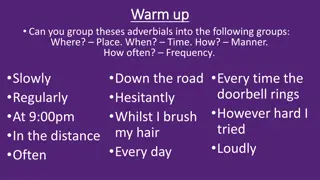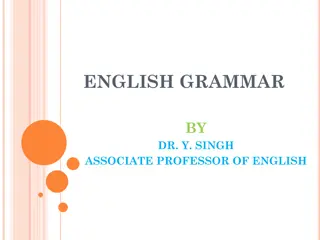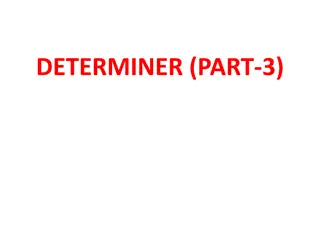Understanding Determiners in English Grammar
Determiners are essential components in English grammar that introduce and describe nouns. They come before nouns and other adjectives. There are four main types of determiners: Articles, Demonstratives, Quantifiers, and Possessives. Articles include indefinite (a, an) and definite (the) articles. Demonstratives such as this, that, these, and those point out specific items. Quantifiers indicate the quantity of the noun, like all, few, and many. Possessives show ownership using words like my, your, his, her, its, our, and their.
Download Presentation

Please find below an Image/Link to download the presentation.
The content on the website is provided AS IS for your information and personal use only. It may not be sold, licensed, or shared on other websites without obtaining consent from the author. Download presentation by click this link. If you encounter any issues during the download, it is possible that the publisher has removed the file from their server.
E N D
Presentation Transcript
LESSON ON DETERMINER (PART-1) A determiner is a word that introduces a noun. It always comes before a noun, not after, and it also comes before any other adjectives used to describe the noun.
There are four different types of determiners in English: Articles, Demonstratives, Quantifiers, Possessives.
Articles Articles are among the most common of the determiners. There are three singular articles: a, an, and the A and an are indefinite articles (used when you are talking about a general version of the noun) For example: A dog is a good pet. An ostrich would beat a chicken in a race. the is a definite article, (refers to a specific noun) For example: We went to the best restaurant in town. The dog is barking too loudly.
Demonstratives Demonstrative pronouns are also used as determiners in English. There are four of them: this, that, these and those. For example: Do you want this piece of chicken? I don't want to go to that movie. These black raspberries are sour. He wanted those boys to go away.
Quantifiers Quantifiers are determiners that indicate how much or how little of the noun is being discussed e.g.--all, few and many For example: He took all the books. She liked all desserts equally. Few children like lima beans, so the cafeteria stopped serving them. Many kittens are taught to hunt by their mothers.
Possessives When referring to a noun that belongs to someone or something, you can use possessive pronouns to show ownership. Possessive pronouns include my, your, his, her, its, our, and their. For example: Where is your car? The dog growled and showed its teeth. My best friend is a cat. Which one is his house? Honesty is her best quality. The tree shed its leaves. It's our secret recipe.
IMPORTANT POINTS Determiners always come first in the noun phrase. Determiners are required with singular nouns. To speak about a singular noun generally, use an indefinite article (a or an) To speak about a plural noun generally, do not use a determiner. To speak about a singular noun specifically, use a definite article, demonstrative pronoun, possessive pronoun or quantifier. To speak about a plural noun specifically, use a definite article, demonstrative pronoun, possessive pronoun or quantifier.























